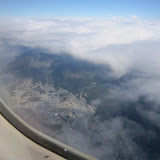Ushuaia is surrounded on all sides by jarringly jagged peaks that are draped with snowy glaciers. The effect of this is that you end up with a surprisingly dramatic vista anytime you're looking down any street in town. The town is built on a hill, with the top part at the northern end and the Beagle Channel--named for Darwin's boat--at the southern border. The Beagle Channel's royal shade of blue forms a striking contrast with the gray, brown, and white peaks all around, meaning that one can just stand by the water and take in the beauty, and nearly forget that your hands are starting to feel a bit numb.
The main street in Ushuaia, San Martín, has a surprisingly familiar range of gear shops for outdoors activities. Hiking and ski shops are more common than basically anything aside from food and lodging. In a lot of ways, Ushuaia resembles a ski town in the states--at least in part because it's a ski down down here in the Winter. It's pretty populous--much more bustle than, say, Penn Yan, NY, but most of the people are just here as part of the tourist economy, be it on the supply side or the consumption side. There isn't much else to rely on, resource-wise. Ushuaia gets most of their basic goods on boats from the mainland--Tierra del Fuego is an island, after all. Most of the early population growth here came out of its service as a penal colony, and the prison remains a tourist destination (which I'll likely visit tomorrow).
I feel like I got through my Buenos Aires wall before I left, and started to appreciate it as a city that really does have a lot to do if you live there. After spending much of my time there feeling sort of underwhelmed (and perhaps overwhelmed at the same time), I left feeling a bit sad to be leaving it behind, though obviously excited for this next phase of the trip. Tomorrow I'll be starting a three-day boat trip down to Cape Horn* and then across the Magellan Strait to Punta Arenas in Chile. I should have some time to explore a bit more of the Land of Fire before I go, but until then I need to get some shut-eye. I doubt I'll have internet on the boat, so I suspect I'll check in a few days from now feeling amazed and seasick.
Saludos,
Seth
*Cape Horn is called Cabo de Hornos in Spanish. This translates as "Cape of the Ovens," which is obviously different from the English meaning. I'm not sure what the origin is, but if I find out I'll pass along the info.
**Tierra del Fuego means "Land of the Fire," an odd name for such a cold place. It gets its name from when Magellan sailed through and saw the many fires the region's indigenous people lit to keep themselves warm at night.
Fotografía:
 |
| Tierra del Fuego |












When we were in Asia, each stop was so stunning, I'd leave saying nothing could top it--nothing! Then the next day, something else would just blow me away. That's how I feel when I see your photos--each place is more breathtaking than the one before.
ReplyDeleteAnd just one of those ice cream penguins is worth a dozen clown cones!
The penguins are meringue. And yes, just wait until I have time to upload pictures from the boat.
ReplyDelete